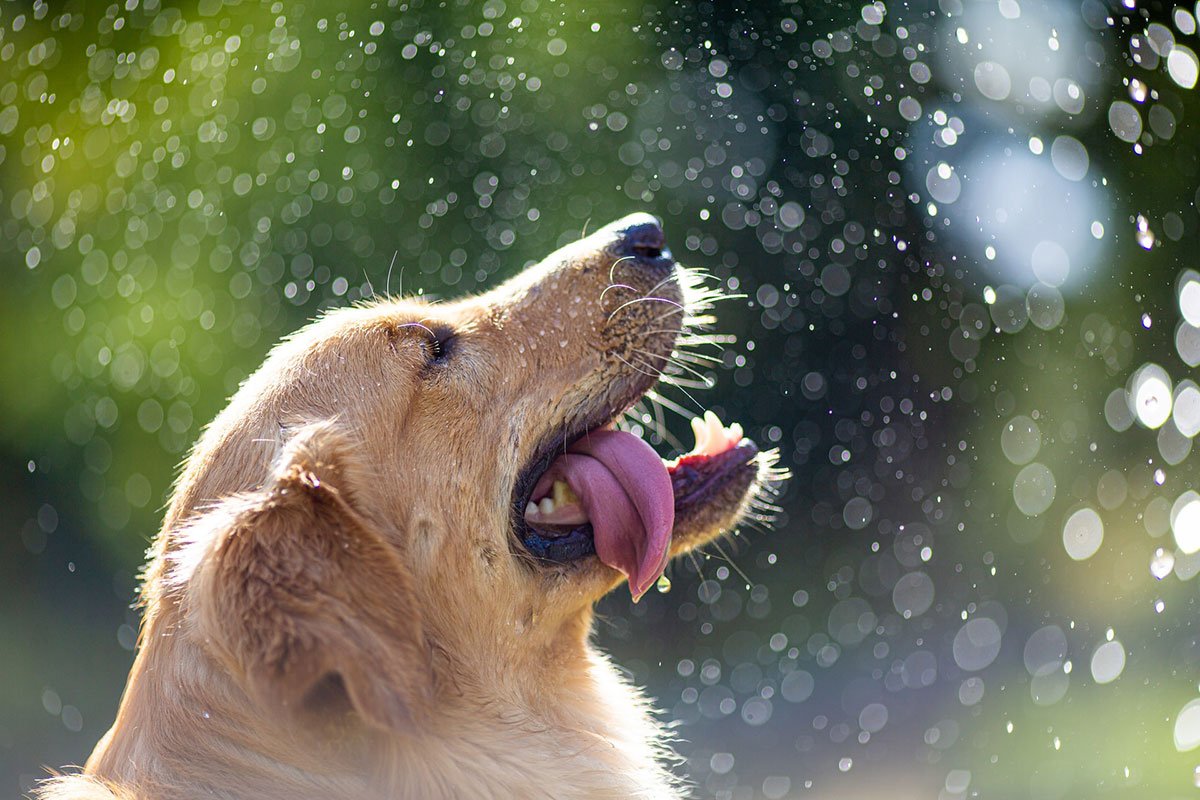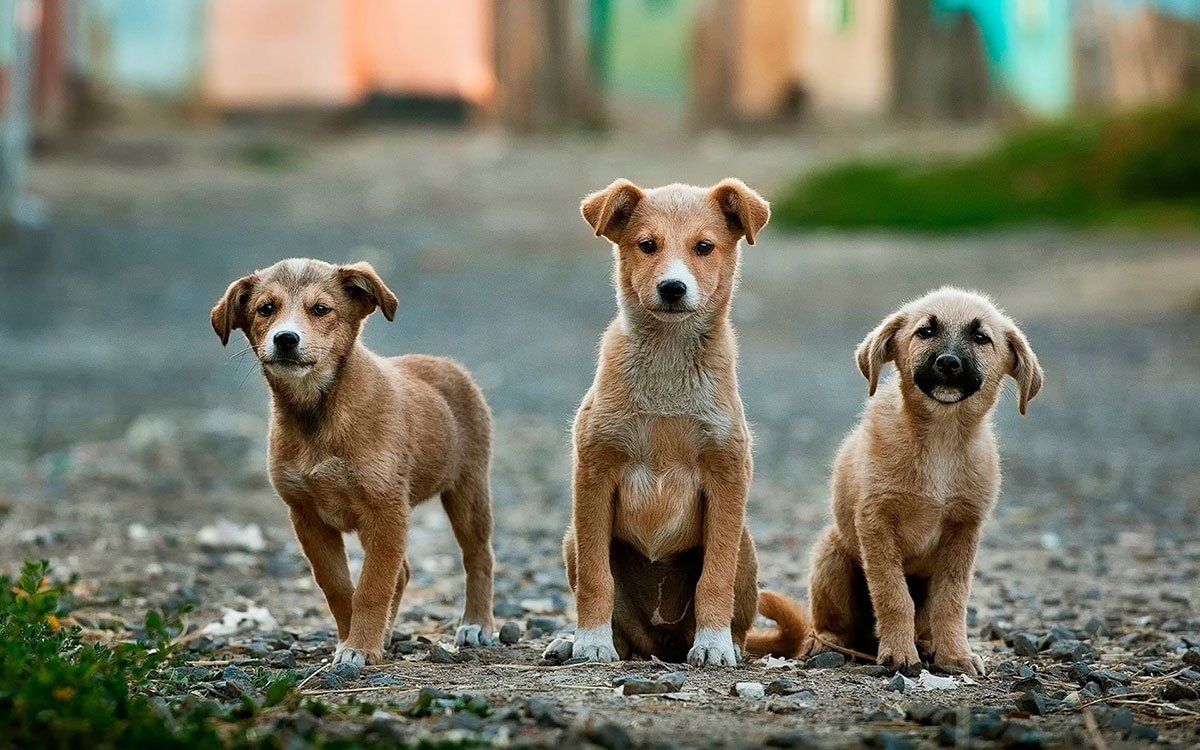Imagine a lively farm with cattle and sheep playing around. This scene shows how animal health is connected to ours. It’s a story about how caring for animals helps our communities and the planet.
Animal health is not just for vets and farmers. It’s a duty for all of us. By understanding this, we can work together. We can use a “One Health” approach to care for animals, humans, and the environment.
Key Takeaways
- Animal health and human health are intricately connected, forming a complex ecosystem.
- Zoonotic diseases, which can be transmitted from animals to humans, highlight the need for a comprehensive “One Health” approach.
- Promoting livestock health and responsible companion animal care are essential for safeguarding public health and food security.
- Biosecurity measures and environmental stewardship are crucial for maintaining the delicate balance of our shared ecosystem.
- Collaborative efforts, research, and strengthened regulatory frameworks are necessary to address emerging challenges in animal health.
Animal health impacts us
Animals, humans, and the environment are all connected. Zoonotic diseases, which can move from animals to humans, show why we must care about animal health. The “One Health” approach brings together different fields like veterinary medicine, public health, and environmental health. It aims to solve big health problems together.
Zoonotic Diseases: Bridging the Gap
Diseases like influenza, rabies, and Lyme disease can jump from animals to people. This is a big risk for disease transmission and public health. By learning how these diseases start and spread, we can find better ways to stop them.
The One Health Approach: A Holistic Perspective
The One Health approach sees animals, humans, and the environment as one big system. It calls for teamwork between vets, doctors, scientists, and others. This way, we can find the real causes of health problems and fix them for good.
| Key Principles of the One Health Approach | Benefits |
|---|---|
|
|
“The health of people is connected to the health of animals and the environment. A One Health approach can help us prevent and respond to health threats more effectively.”
Promoting Livestock Health
Keeping our livestock healthy is key to a safe and sustainable food supply. We use animal husbandry, disease prevention, and biosecurity to protect them. This helps prevent zoonotic diseases and supports sustainable farming.
Good animal care is essential. We give them the best living conditions, food, and vet care. Regular health checks, vaccinations, and quick treatment of sicknesses keep them well.
Biosecurity is also vital. We control who enters farms, disinfect thoroughly, and watch for disease carriers. This lowers disease risk in our herds.
By focusing on livestock health, we ensure our food is safe and high quality. Healthy animals need less resources, make less waste, and are less likely to get sick. This makes our food systems more efficient and green.
| Livestock Health Strategies | Key Benefits |
|---|---|
| Optimal Animal Husbandry | Improved animal welfare, higher productivity, and reduced disease risk |
| Comprehensive Biosecurity Measures | Effective prevention of disease introduction and transmission within livestock herds |
| Proactive Disease Monitoring and Treatment | Early detection and management of health issues, minimizing productivity loss and potential outbreaks |
| Sustainable Farming Practices | Improved resource efficiency, reduced environmental impact, and enhanced food security |
By focusing on livestock health, we protect our food, reduce disease risks, and help make farming more sustainable.
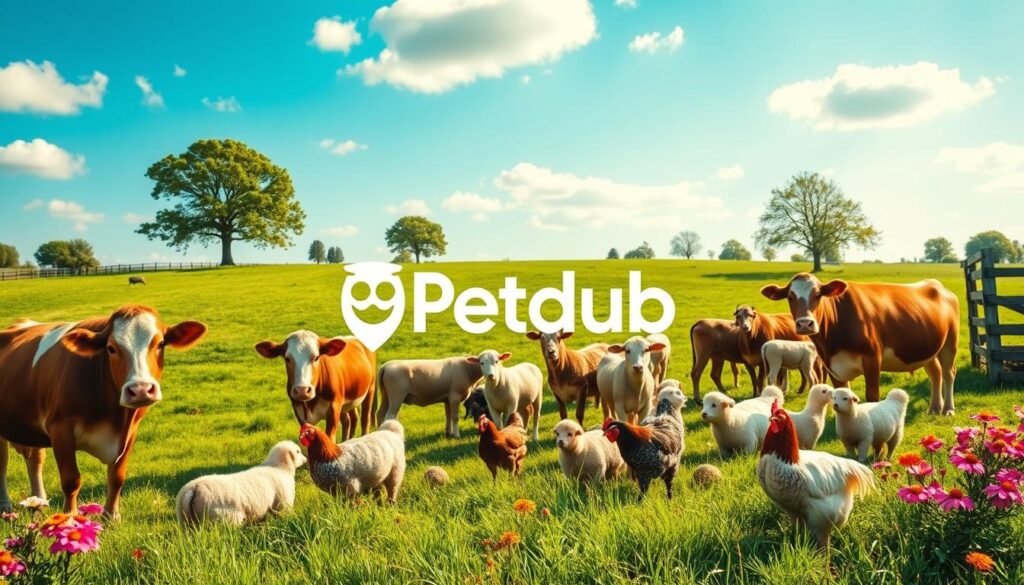
“Healthy livestock are the foundation of a thriving food system. By investing in their wellbeing, we not only ensure the quality of our food, but also pave the way for a more sustainable future.”
Responsible Companion Animal Care
Companion animals, like pets, are very special to us and our communities. Taking good care of them, including regular vet visits and preventive steps, helps them and keeps us healthy. It reduces disease risks and boosts overall health.
Veterinary Medicine: A Crucial Role
Veterinary medicine is key to keeping our pets healthy. Regular vet visits help catch and prevent health problems early. This improves our pets’ lives greatly. Veterinarians give top-notch care, from routine checks to special treatments.
Pet Wellness and Prevention
Keeping our pets well is vital for their health and happiness. This means giving them the right food, exercise, and preventive care like shots and flea control. By meeting our pets’ needs, we avoid serious health issues and keep them happy.
Looking after our pets is not just good for them; it’s good for all of us. By focusing on vet care and pet wellness, we help our pets live well. We also help prevent diseases and improve public health.
“The greatness of a nation and its moral progress can be judged by the way its animals are treated.” – Mahatma Gandhi
Biosecurity: Safeguarding Our Food Supply
Keeping our food system safe is key for public health and food availability. Biosecurity is crucial in this effort. It protects our food from threats. From farms to distribution, a strong biosecurity approach stops disease spread, keeps food quality high, and makes our food system stronger.
Farm-to-Table Safety Measures
Farm-to-table safety measures are vital for disease prevention and food safety. On farms, biosecurity includes cleaning, animal health checks, and limited access. This reduces disease risk. In processing and distribution, strict cleanliness, temperature control, and tracking systems keep food quality and safety.
- Implement robust on-farm biosecurity practices, such as:
- Proper sanitation and disinfection procedures
- Routine animal health monitoring and disease surveillance
- Controlled access to production areas
- Enforce stringent food safety protocols during processing and distribution, including:
- Adhering to strict hygiene and sanitation standards
- Maintaining appropriate temperature control throughout the supply chain
- Implementing comprehensive traceability systems
By focusing on biosecurity and farm-to-table safety measures, we protect our food supply. This ensures public health and supports a sustainable food production system.
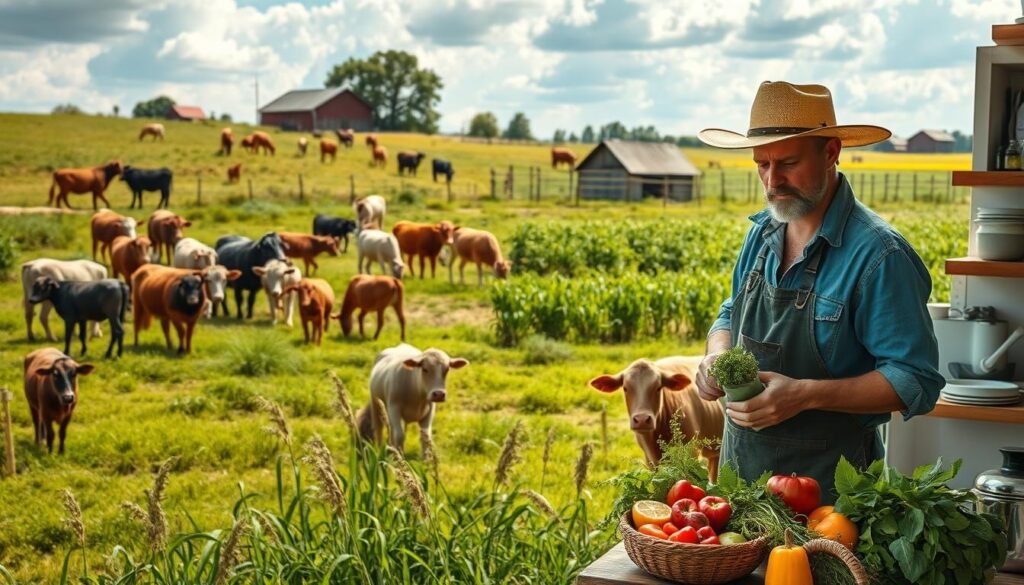
“Effective biosecurity is the first line of defense in protecting the integrity of our food supply and ensuring the health and well-being of our communities.”
Environmental Health and Animal Welfare
The connection between environmental health and animal welfare is key. We must work to keep our ecosystems in balance. By focusing on sustainable practices, we can protect biodiversity and ensure a better future for all.
Keeping the environment healthy is crucial for animals. They need clean air, water, and resources to survive and thrive. On the other hand, animal welfare is vital for the health of our ecosystems. When animals are well, they help keep our natural world in balance.
Practices like responsible resource use, pollution control, and habitat restoration help both the environment and animals. These steps reduce the harm caused by humans and help us live in harmony with animals.
| Environmental Factors | Impact on Animal Welfare |
|---|---|
| Air and water quality | Respiratory health, hydration, and overall well-being |
| Habitat availability and connectivity | Ability to thrive, find food and shelter, and maintain natural behaviors |
| Biodiversity conservation | Interspecies interactions, resource availability, and ecosystem resilience |
| Pollution and climate change mitigation | Reduction of environmental stressors and threats to animal health |
By focusing on environmental health and animal welfare, we can build a better world. A world where the ecosystem balance is maintained and biodiversity flourishes for future generations.
“The fate of the living planet is the fate of all living things, including humanity. We cannot protect the health of the environment without also protecting the health and welfare of the animals that inhabit it.”
Animal Health is Everyone’s Health
The idea that “Animal Health is Everyone’s Health” shows how animals, humans, and the environment are connected. By working together and using a one health approach, we can tackle big health problems. This helps keep public health safe and makes a better future for everyone.
Zoonotic diseases, which animals can give to humans, are a big problem today. This shows we need to work together to fight these diseases. The one health approach sees how animals, humans, and the environment are linked. It also shows we all have to work together to keep this balance.
Everyone and every group has a part to play in keeping animal health safe. This includes taking care of livestock and pets, keeping food safe, and protecting the environment. By joining forces, we can stop diseases from spreading, make food safer, and improve our ecosystem’s health.
| Key Strategies for Promoting Animal Health |
|---|
|
By following the one health approach, we can build a stronger and more sustainable world. It’s our duty to work together. We must use our knowledge and resources to protect our planet and all living things.

“Animal health is not just a veterinary issue – it’s a public health issue, an environmental issue, and an economic issue. We all have a role to play in ensuring the health and safety of animals, and in turn, the health and safety of our communities and our planet.”
Collaborative Efforts in Disease Prevention
Stopping diseases needs everyone’s help. We must work together, combining our skills and resources. This way, we can tackle animal health issues and their effects on people and the planet.
Public-Private Partnerships
Working together, the public and private sectors can do more. Governments, research places, and companies can share their knowledge and tools. This helps us make better policies, track diseases better, and make prevention easier.
These partnerships let us share ideas and use the best practices. They also bring together experts from different fields. This is key for tackling disease prevention, global health, and sustainable development together.
| Collaborative Approach | Benefits |
|---|---|
| Public-Private Partnerships |
|
| Interdisciplinary Cooperation |
|
By working together, we can fight diseases better. This leads to a healthier, greener future for all.
“When we work together, we can achieve so much more in the fight against disease and the pursuit of global health and sustainability.”
Investing in Research and Innovation
Investing in research and innovation is key to better understanding animal health. It helps us know how it affects humans and the environment. By supporting new discoveries and technologies, we can improve disease prevention and healthcare for animals.
Our efforts help fight diseases like HIV/AIDS and malaria. They also tackle challenges from climate change and urban growth. Our focus on research and innovation protects animal health worldwide.
“Investing in animal health research is not just about protecting our four-legged friends – it’s about ensuring the overall wellbeing of our planet and its inhabitants.”
Using new technologies and working together, we can solve big animal health problems. This supports global efforts to prevent diseases.
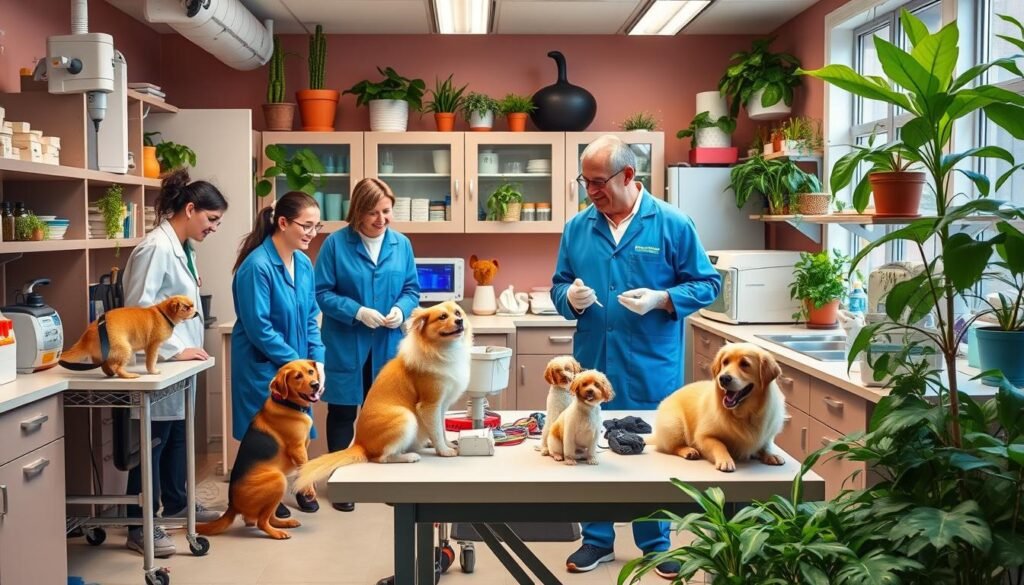
Fostering a Culture of Innovation
To keep moving forward in animal health, we need to value and encourage innovation. This means:
- More money for animal health research and development
- Building partnerships between public and private sectors
- Making it easier to use new technologies
- Encouraging teamwork and sharing knowledge
With this approach, we can explore new areas in animal health. We can create a future where all creatures are cared for.
Strengthening Regulatory Frameworks
Strong and unified rules are key for animal health, public safety, and green practices. Global teamwork helps us make policies that tackle animal health issues. It also lets us share knowledge and best practices, leading to a unified effort.
Global Coordination and Cooperation
Working together internationally is vital for better animal health rules. Nations, groups, and experts joining hands can create uniform regulatory frameworks. This way, animal health regulations and policy development can tackle global problems together. It means sharing resources and expertise, boosting animal health worldwide.
| Regulatory Aspect | Global Coordination Initiatives |
|---|---|
| Zoonotic Disease Control | The World Organization for Animal Health (OIE) and the World Health Organization (WHO) work together to stop zoonotic diseases. This is a big step in international cooperation. |
| Veterinary Medication Standards | The Codex Alimentarius Commission, a joint effort by the Food and Agriculture Organization (FAO) and the WHO, sets rules for animal health regulations on vet drugs and food safety. |
| Livestock Movement and Trade | Groups like the European Union and the African Union have made rules for safe animal and product movement. This helps trade and health across borders. |
By boosting these teamwork efforts, we can make sure regulatory frameworks and animal health regulations stay up-to-date. This promotes global coordination and international cooperation. It’s good for both animal and human health.
Education and Awareness Programs
Teaching people about animal health is key. It helps us understand how animals, humans, and the environment are connected. This knowledge leads to behavior change and more public engagement in protecting all living beings.
There are many ways to educate and raise awareness. This includes school programs, community events, and online campaigns. These efforts should:
- Teach about zoonotic diseases and the need for responsible pet and livestock care
- Show the importance of biosecurity to keep our food safe and prevent disease spread
- Emphasize the vital role of veterinarians and their services
- Encourage practices that support environmental health and animal welfare
By teaching and inspiring people, we can create a culture of shared responsibility. Together, we can ensure a future where animal health matters to everyone.
“The greatness of a nation and its moral progress can be judged by the way its animals are treated.”
– Mahatma Gandhi

The Economic Impact of Animal Health
Animal health is key to keeping our economy strong and meeting the Sustainable Development Goals. By focusing on the health of livestock, we can make big strides in boosting livestock productivity. This leads to better food security and sustainable growth.
The effects of animal health reach far, touching industries like livestock, dairy, meat processing, and international trade. Healthy animals mean more food and higher profits for farmers. This boosts the whole food security chain, giving everyone access to nutritious food.
Sustainable Development Goals
The Sustainable Development Goals (SDGs) highlight the link between animal health and economic growth. By linking our animal health plans with the SDGs, we can make progress in many areas. This includes:
- Ending poverty and hunger (SDGs 1 and 2) by boosting livestock productivity and food supplies
- Promoting responsible consumption and production (SDG 12) through green animal farming
- Combating climate change (SDG 13) by lowering the environmental footprint of livestock
- Fostering partnerships and cooperation (SDG 17) to tackle global animal health issues
By focusing on animal health, we can bring about big changes. This unlocks the economic potential in our livestock systems, helping communities all over the world.
“Investing in animal health is not just a moral imperative, but an economic necessity for a sustainable future.”
Ethical Considerations in Animal Health
Ensuring the health and welfare of animals is a complex task. We must consider many ethical factors. As caretakers, we have a duty to treat animals with respect and care. This means making choices that benefit both animals and humans, while also protecting the environment.
Veterinary ethics guides us in making these tough decisions. It helps us understand the unique needs of animals. We must always choose treatments that improve their lives and avoid causing them pain.
Animal welfare goes beyond just physical health. It includes their emotional, psychological, and social well-being. By showing compassion and respect, we can improve their lives and fulfill our moral duties.
Our actions in animal health reflect our humanity. By prioritizing animal welfare, we can create a better world. A world where all living beings are valued and protected.
“The greatness of a nation and its moral progress can be judged by the way its animals are treated.” – Mahatma Gandhi

Balancing Competing Interests
In animal health, we often face tough choices. We must balance the needs of animals, humans, and the environment. This means weighing the benefits of treatments against the potential harm to animals.
- Prioritizing animal welfare while considering human health and safety
- Ensuring that research and experimentation adhere to the highest ethical standards
- Promoting sustainable and humane practices in agriculture and livestock management
- Fostering a culture of compassion and respect for all living beings
Embracing Animal Rights
We have a moral duty to protect animals’ rights. This means supporting laws that protect them and educating people about animal welfare.
- Ensuring that animals are not subjected to cruelty, neglect, or unnecessary suffering
- Promoting the humane treatment of animals in all aspects of our lives, including food production, entertainment, and companionship
- Empowering veterinary professionals to make ethical decisions that prioritize the interests of their animal patients
- Collaborating with animal welfare organizations to amplify the voices of those who cannot speak for themselves
| Ethical Principle | Application in Animal Health |
|---|---|
| Beneficence | Ensuring that medical interventions and care practices promote the overall wellbeing of animals |
| Non-maleficence | Avoiding actions that could cause harm or undue suffering to animals |
| Autonomy | Respecting the natural behaviors and preferences of animals, and minimizing interference with their autonomy |
| Justice | Ensuring fair and equitable treatment of animals, regardless of species or perceived value |
Emerging Challenges and Future Directions
The world of animal health is always changing, bringing both challenges and chances for growth. We face issues like disease outbreaks and climate change. To tackle these, we need to stay alert and find new ways to protect animals and our planet.
Confronting Disease Outbreaks
Disease outbreaks are becoming more common and severe in animals. This includes diseases that can spread from animals to people. We must get better at spotting these diseases early and responding quickly. This means improving our detection systems and working together more closely.
Adapting to Climate Change
Climate change is also affecting animal health. Changes in weather and habitats can lead to new health problems. We need to fund research to understand these changes and find ways to help animals and their owners adapt.
| Emerging Challenge | Potential Impact | Proposed Solutions |
|---|---|---|
| Disease Outbreaks | Increased risk of zoonotic diseases, livestock epidemics, and companion animal health issues | Enhanced early detection, improved biosecurity, and strengthened collaboration among stakeholders |
| Climate Change | New disease vectors, disrupted food and water supplies, and exacerbated health problems | Invest in research to understand evolving dynamics and develop adaptive strategies |
By facing these challenges and looking to the future, we can improve animal health. This will also help protect humans and the environment. It’s crucial for keeping our ecosystems strong and sustainable.
“The health of animals, humans, and the environment are inextricably linked. By working together to tackle emerging challenges, we can create a brighter future for all.”
Why pets are good for our health
Conclusion
Looking at “Animal Health is Everyone’s Health,” we see how vital animal care is. It affects us all. By using a One Health approach, we can tackle health issues better. This way, we also help the environment and make a better future.
We all play a part in keeping animals healthy. This is key to our world’s health. By supporting animal health, we improve public health and ensure a sustainable future.
It’s time for us to act. We must care for animal, human, and environmental health together. Let’s work across sectors and borders to create a better world for everyone.



